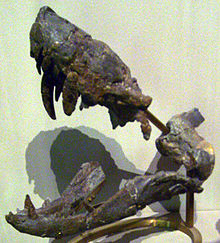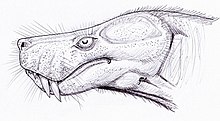| Lycosuchus Temporal range: Middle Permian,
| |
|---|---|

| |
| Lycosuchus vanderrieti skull (MB.R.995) at the Museum für Naturkunde, Berlin | |
| Scientific classification | |
| Domain: | Eukaryota |
| Kingdom: | Animalia |
| Phylum: | Chordata |
| Clade: | Synapsida |
| Clade: | Therapsida |
| Clade: | †Therocephalia |
| Family: | †Lycosuchidae |
| Genus: | †Lycosuchus Broom, 1903 |
| Species: | †L. vanderrieti
|
| Binomial name | |
| †Lycosuchus vanderrieti Broom, 1903
| |
Lycosuchus ("wolf crocodile") is an extinct genus of carnivorous therocephalians which lived in the Middle Permian 265—260 Ma existing for approximately 5 million years. As a member of the Lycosuchidae, the genus represents one of the earliest diverging therocephalians. The type and only species, L. vanderrieti, is known from a handful of well-preserved specimens featuring the cranium and lower jaw; the holotype US D173 housed at the University of Stellenbosch, South Africa, is a near complete occluded skull.[1] Specimen MB.R. 995, housed at the Museum für Naturkunde Berlin, Germany, consists of a near complete and isolated lower jaw, along with a partial snout and brain case.[2] With the help of μCT data, Pusch et al (2020) [2] described the endocranial anatomy of Lycosuchus vanderrieti.

It was a medium-sized predator, reaching 1.2 m (3.8 ft) in length with a skull 23 cm long.,[3] typical of early therocephalians. L. vanderrieti bore two functional canines in each maxilla, possibly due to a protracted tooth replacement.[2] Both the upper canines and the single canine of the lower jaw are serrated.
Discovered in South Africa, it was named by paleontologist Robert Broom[4] in 1903 and later assigned by him to Therocephalia.
See also
[edit]Notes and references
[edit]- ^ J.A. Van den Heever (1987) The comparative and functional cranial morphology of the early Therocephalia (Amniota: Therapsida) p. 322
- ^ a b c Pusch, Luisa C.; Ponstein, Jasper; Kammerer, Christian F.; Fröbisch, Jörg (2020). "Novel Endocranial Data on the Early Therocephalian Lycosuchus vanderrieti Underpin High Character Variability in Early Theriodont Evolution". Frontiers in Ecology and Evolution. 7: 1–27. doi:10.3389/fevo.2019.00464.
- ^ T.S. Kemp (2005) The origin and evolution of mammals p.55
- ^ R. Broom (1913) A revision of the reptiles of the Karroo
- R. Broom (1913) A revision of the reptiles of the Karroo. Annals of the South African Museum 7(6):361-366
External links
[edit]- http://fossils.valdosta.edu/fossil_pages/fossils_per/t72.html Cast of skull and jaw courtesy of the National Museum, Bloemfontein South Africa



Well, that’s interesting to know that Psilotum nudum are known as whisk ferns. Psilotum nudum is the commoner species of the two. While the P. flaccidum is a rare species and is found in the tropical islands. Both the species are usually epiphytic in habit and grow upon tree ferns. These species may also be terrestrial and grow in humus or in the crevices of the rocks.
View the detailed Guide of Psilotum nudum: Detailed Study Of Psilotum Nudum (Whisk Fern), Classification, Anatomy, Reproduction